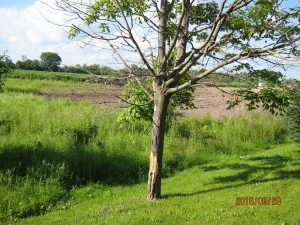
I have a 25 year old Japanese maple tree that has been losing leaves and branches over the past 6 years. The bark looks like it may have a fungus of some sort. The bark is peeling off near the base and there are whitish patches on the tree trunk. Can this tree be saved?
Thank you for contacting the Toronto Master Gardeners.
From you photo it appears that your Japanese Maple has suffered numerous injuries to it’s bark. There appears to be an older injury properably a result of sunscald or southwest injury. This type of bark-splitting is thought to result from very cold temperatures on sunny winter days and is often associated with southwest exposure. On bright sunny days the southwest side of the tree heats up, absorbing the heat of the sun. When the sun sets or goes behind a cloud, there is a sudden freezing of the warm tissue. This sun scald results in the death of the exposed bark. The result is a vertical fissure down the center of the tree trunk, causing strips of bark to peel off, exposing the tree’s inner wood. Frost cracks may cause stress for your tree and provide a point of entry for pests and diseases. Damage from sunscald injury may eventually heal.
There also appears to be a secondary damage near the base of the tree which could have been the result of mechanical or wildlife damage. Birds may be looking for insects in the crack or tear of the bark. Do you see any holes in the bark? Beetles bore holes in the bark to the cambium layer and lay eggs. The larvae are what causes the initial damage to the bark, and then other wildlife looking for them, may peel and damage the bark further.
Although it is difficult to see on the photograph the whitish patches that you mention could be lichens and are a common feature on many trees. The vast majority of lichens present absolutely no harm to the tree. What Causes those White Splotches on Tree Bark? is an excellent article describing the imapct of lichen to the tree.
When a tree receives a trunk wound that penetrates the cambium layer it can interfere with the movement of water and nutrients.A wound can become a pathway for diseases, insects or decay. Since there is no leaf growth on a number of your branches and you have been losing leaves and branches every year it is possible that the tree is dying, but you may want to consult an arborist before removing the tree. Here is a link to a certified arborist in your area: www.isaontario.com/content/public
In case you have other Japanese Maple trees you may wish to refer to our Gardening Guide on Growing Japanese Maples
Good Luck with your Japanese Maple Tree.

